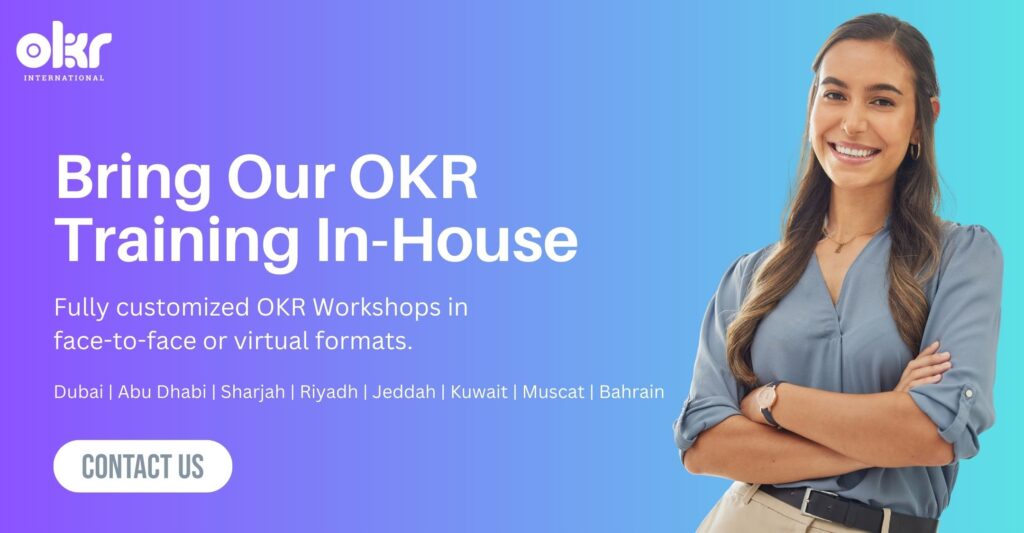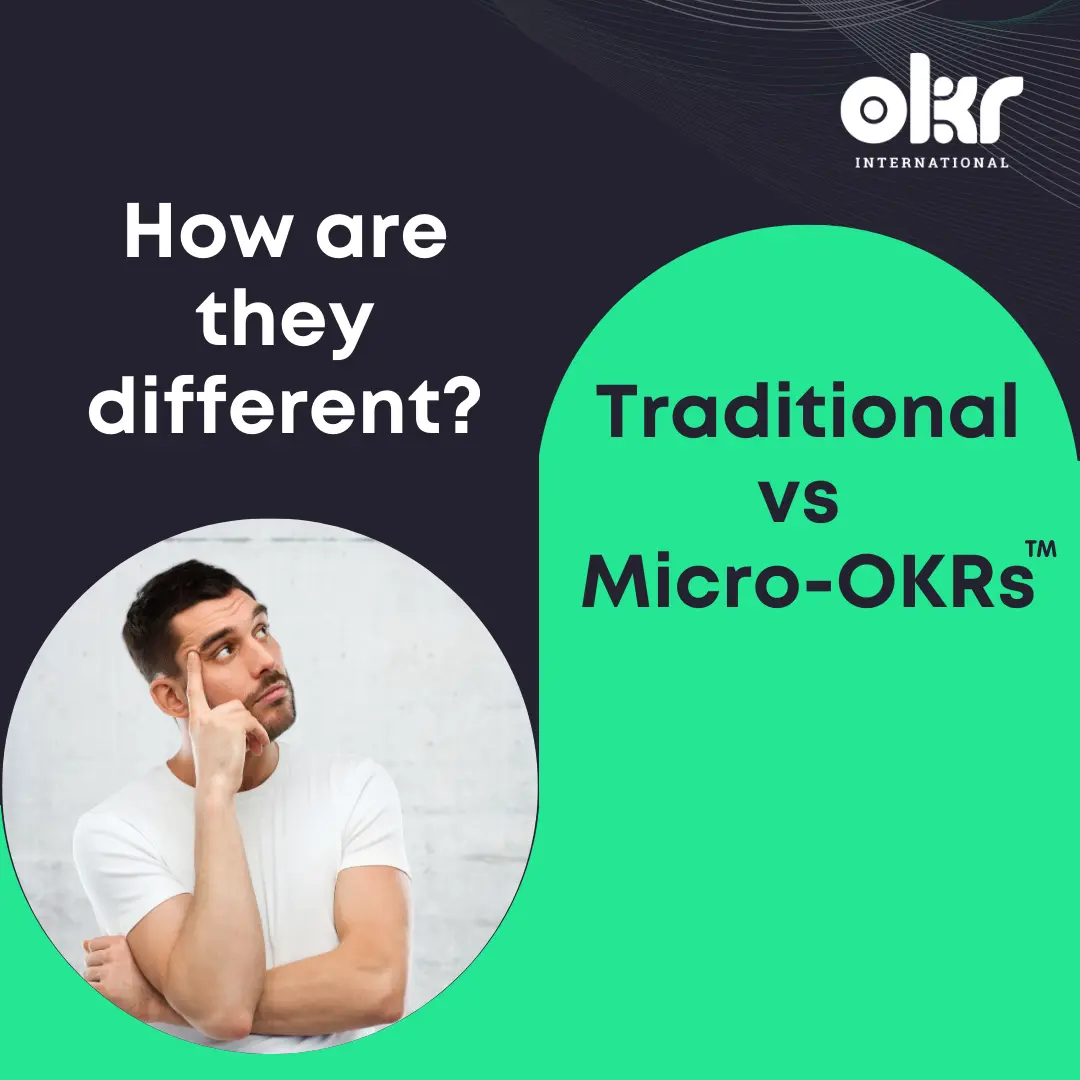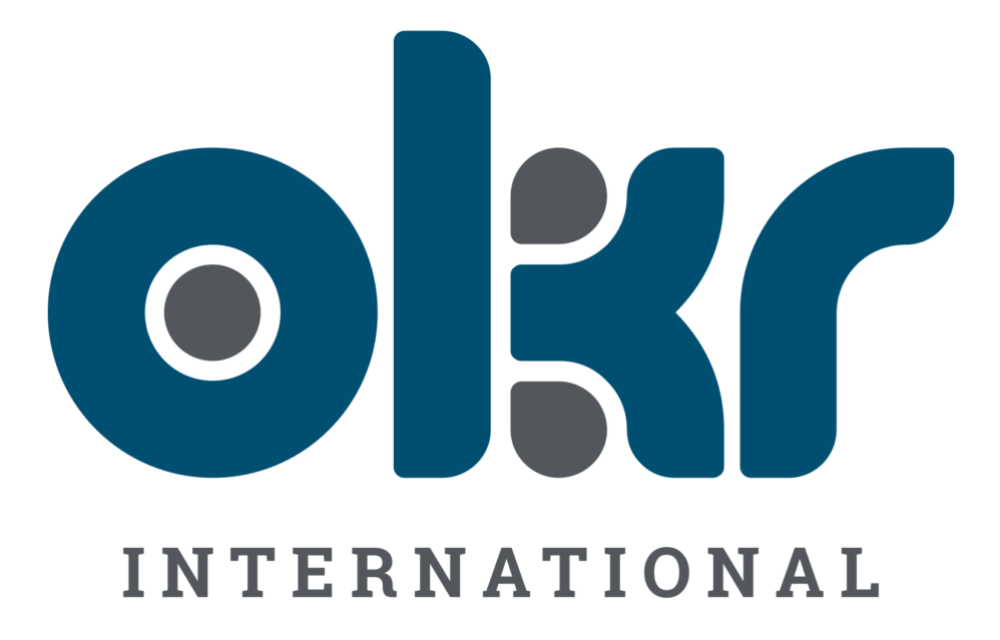Key Differences Between Micro-OKRs™ and Traditional OKRs: A Comprehensive Guide
In 2024, Nikhil Maini, CEO of OKR International, introduced a groundbreaking shift in goal-setting frameworks with the advent of Micro-OKRs™. This new methodology emerged as a direct response to the increasing need for agility and flexibility in businesses. While the traditional Objectives and Key Results (OKRs) framework has been widely adopted, Micro-OKRs™ offer a more short-term, actionable alternative designed to keep businesses nimble in dynamic and unpredictable environments. But how do Micro-OKRs™ truly differ from traditional OKRs? Below, we explore the key distinctions, offering examples and insights to understand when and how each should be employed.
1. Time Frame: Short-Term Focus vs. Long-Term Vision
One of the most fundamental differences between Micro-OKRs™ and traditional OKRs lies in their time frames.
Traditional OKRs: Long-Term, Strategic Planning
Traditional OKRs are typically set for a longer period—often annually and/or quarterly. These OKRs are designed to focus on significant, strategic goals that require sustained effort and collaboration across multiple teams or departments. The extended time frame allows organizations to collect data, implement strategies, and monitor progress in alignment with overarching business objectives.
Example: A financial services firm may set a traditional OKR to reduce customer acquisition costs by 10% over the course of a year or a quarter. This allows the company to test different marketing strategies, analyze performance data, and make adjustments over time.
Micro-OKRs™: Immediate, Tactical Execution
In contrast, Micro-OKRs™ are much more short-term in nature, often set for a week, two weeks, or at most, a month. These OKRs focus on highly specific, actionable tasks that can generate quick results. By emphasizing rapid execution, Micro-OKRs™ help teams remain agile and responsive, particularly in fast-moving environments.
Example: A retail brand might set a Micro-OKR™ to optimize email open rates for an upcoming Black Friday campaign, with a goal to achieve a 5% increase within a week. This quick objective allows the team to test different subject lines, calls to action, and promotional content in a short window, ensuring maximum impact during a crucial sales period.
2. Granularity: Broad Goals vs. Precise Tasks
The scope of the goals set in traditional OKRs versus Micro-OKRs™ is another critical differentiator.
Traditional OKRs: Broad, Cross-Functional Objectives
Traditional OKRs typically involve broader goals that span multiple departments or even the entire organization. These goals require high-level coordination and effort from various teams to align with the company’s long-term strategic vision.
Example: A tech company might set a traditional OKR to improve user retention by 20% over the course of a year. Achieving this objective would require collaboration between product development, marketing, and customer support teams, with each group contributing their expertise.
Micro-OKRs™: Narrow, Task-Level Focus
Micro-OKRs™, by contrast, drill down into the granular details. They focus on smaller, task-level objectives that are specific and quickly actionable. These precise goals often apply to a single team or even an individual, making them easier to complete in a short time frame.
Example: A manufacturing firm might create a Micro-OKR™ to boost production line output by 5% within one month. This goal would involve making small, tactical adjustments to machinery, processes, or workflows to achieve immediate improvements in efficiency.
3. Purpose: Strategic Alignment vs. Tactical Execution
The purpose behind traditional OKRs and Micro-OKRs™ further illustrates their differences.
Traditional OKRs: Aligning with Long-Term Strategy
Traditional OKRs are typically designed to align with long-term strategic priorities. They lay the groundwork for broader organizational success by setting clear, measurable goals that map directly to the company’s vision and mission. These objectives are often more ambitious, requiring substantial effort and long-term focus.
Example: A pharmaceutical company might set a traditional OKR to bring a new drug to market within the next six months. This would involve complex steps such as extensive testing, securing regulatory approvals, and developing a comprehensive marketing plan.
Micro-OKRs™: Focused on Immediate, Tactical Outcomes
Micro-OKRs™, on the other hand, serve a more tactical purpose. They focus on immediate results that can be achieved through rapid execution. This makes them ideal for situations where organizations need to act fast, gather quick feedback, and iterate on solutions.
Example: The same pharmaceutical company could use a Micro-OKR™ to secure a critical regulatory document within a week, ensuring that the broader product launch stays on track. The focus here is on completing a single, high-priority task as quickly as possible.
4. Flexibility: Structured Planning vs. Adaptable Frameworks
Flexibility is a key advantage that sets Micro-OKRs™ apart from traditional OKRs.
Traditional OKRs: Structured and Stable
Traditional OKRs generally operate within a more structured framework, with limited room for frequent adjustments. Given that these OKRs are often tied to long-term goals, the emphasis is on sustained effort and stability rather than constant iteration.
Example: An automotive company might set a traditional OKR to develop a new electric vehicle model over the next 18 months. This long-term goal requires a stable, ongoing commitment from multiple departments, including engineering, design, marketing, and supply chain management.
Micro-OKRs™: Rapid Adjustment and Flexibility
Micro-OKRs™ are far more flexible, allowing teams to pivot quickly in response to feedback or changing circumstances. This adaptability makes Micro-OKRs™ particularly well-suited for dynamic environments, such as startups or industries that are subject to frequent disruption.
Example: A software development team might establish a Micro-OKR™ to fix a critical bug in a mobile app within two weeks. By iterating on potential solutions and releasing updates in real-time, the team can quickly address user feedback and stabilize the app.
5. Application Level: Organizational vs. Individual Focus
Another notable distinction between traditional OKRs and Micro-OKRs™ lies in their level of application. Read more on 3 Levels of OKRs.
Traditional OKRs: Organizational and Departmental Goals
Traditional OKRs are often set at higher levels within the organization, typically at the departmental or organizational level. They are designed to ensure that entire teams or business units align toward common strategic priorities.
Example: A telecommunications company may set a traditional OKR for the customer service department to increase customer satisfaction scores by 15% over the next quarter. This goal would involve initiatives like employee training, process improvements, and technology upgrades across the department.
Micro-OKRs™: Individual and Small Team Objectives
In contrast, Micro-OKRs™ are more commonly applied at the individual or small team level. These objectives tend to be very focused and are designed to be achieved quickly, often without the need for extensive cross-functional collaboration.
Example: A marketing team could set a Micro-OKR™ to increase click-through rates on a particular ad campaign by 10% within two weeks. The team would focus on optimizing the campaign content, improving targeting, and adjusting the messaging to meet the goal.
6. Risk and Experimentation: Established Goals vs. High-Risk Innovation
Risk tolerance and experimentation also distinguish Micro-OKRs™ from their traditional counterparts.
Traditional OKRs: Lower-Risk, Established Objectives
Traditional OKRs typically involve lower-risk goals that are crucial for long-term organizational success. These objectives are often well-established and involve tried-and-true strategies that align with the company’s broader mission.
Example: A logistics company might set a traditional OKR to expand warehouse capacity by 20% over the next year. This goal would require careful planning, resource allocation, and collaboration across various teams to ensure success.
Micro-OKRs™: High-Risk, Experimental Projects
Micro-OKRs™, on the other hand, are well-suited for high-risk, experimental initiatives. These objectives allow teams to test new ideas, gather feedback quickly, and iterate based on real-time data. The short time frame of Micro-OKRs™ encourages fast experimentation with minimal risk to the broader organization.
Example: A fashion brand could use a Micro-OKR™ to pilot a new clothing line in a specific region for one month. The company would closely monitor consumer feedback and sales data, making quick adjustments before deciding whether to roll out the product on a larger scale.
7. Feedback and Iteration: Slow vs. Fast Feedback Loops
Finally, the feedback cycle for traditional OKRs and Micro-OKRs™ varies significantly.
Traditional OKRs: Slower Feedback Loops
With traditional OKRs, feedback is generally gathered at the end of a quarter or year. This means that adjustments and course corrections are slower, as teams must wait until the conclusion of the OKR cycle to evaluate progress and make changes.
Example: A consulting firm might set a traditional OKR to increase its client base by 15% over the course of a quarter. At the end of the three-month period, the firm would assess its progress and make adjustments to its business development strategies.
Micro-OKRs™: Rapid Feedback and Continuous Iteration
Micro-OKRs™ operate with much faster feedback loops, enabling teams to make real-time adjustments. This immediacy allows for quick experimentation and course correction, making Micro-OKRs™ ideal for fast-paced, data-driven environments.
Example: A digital marketing agency could set a Micro-OKR™ to improve the performance of a paid advertising campaign over the course of two weeks. The team would continuously monitor key metrics, such as click-through rates and conversion rates, making daily or even hourly adjustments to optimize performance.

Conclusion
So when does one use Micro-OKRs™ vs. Traditional OKRs?
Both Micro-OKRs™ and traditional OKRs have their place in a modern goal-setting framework. Deciding which approach to use depends on the unique needs of your organization and the specific challenges you’re facing.
- Use traditional OKRs when pursuing long-term, strategic goals that require alignment across multiple departments or teams.
- Use Micro-OKRs™ when immediate action, rapid feedback, or a short-term focus is needed, particularly in dynamic environments where conditions change quickly.
Many organizations may find that a hybrid approach—using both Micro-OKRs™ and traditional OKRs—offers the best of both worlds. This allows for big-picture alignment through traditional OKRs, while Micro-OKRs™ provide the agility needed to respond to short-term opportunities and challenges.
By effectively balancing these two approaches, businesses can achieve long-term success while maintaining the flexibility to adapt in an ever-changing world.

Join the Upcoming OKR Coach Certification Workshop
Ready to transform your strategic acumen and propel your organization forward? Enroll today and take the first step towards mastering OKRs with our Certified OKR Practitioner program!
- Dates: 25-26 Oct. 2024
- Session Timings: 07:00 – 15:00 UTC / 12:30 – 20:30 IST / 09:00 – 17:00 CET
- Language: English
- ICF & HRCI Credits: 16
- Enrollment Fee: $1500
Learn More | Download Flyer | Register & Pay Now
Contact Us
Mail: info@okrinternational.com
WhatsApp Message: +971.552160708



